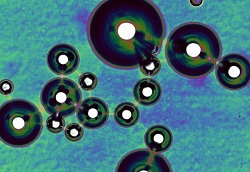 |
| Imaging microbubbles may now be able to carry drugs.--Courtesy of Imperial College London |
Glowing microbubbles injected into the bloodstream to enhance medical imaging may also prove useful as drug-delivery vehicles, London researchers have found.
The Imperial College London and University of Oxford scientists illuminated small air-filled bubbles to track blood flow with medical imaging by inserting a luminescent molecule underneath their outer shells. With ultrasound imaging, the lipid-based particles provided a blood-tracking mechanism, but beyond that, their specific properties were unknown and unpredictable.
But by mapping the bubbles' shells with a powerful microscope, the team found that they were capable of carrying drugs due to their flexibility and stability, as well as their ability to target certain parts of the body.
"The new technique can potentially have a big impact on our understanding of how microbubbles interact with living cells and each other in blood vessels," said Imperial lead researcher Marina Kuimova in a statement. "We can now begin work on how to manipulate or manufacture microbubbles for use in medical treatments."
The researchers published their findings in the Proceedings of the National Academy of Sciences.
"This valuable new method will enable us to understand how the microbubble manufacturing techniques we are developing affect the properties of the microbubbles," added Oxford researcher Eleanor Stride, "and hence how we can optimize their response to ultrasound for both imaging and drug delivery applications."
- here's the Imperial College London report
- get the research abstract